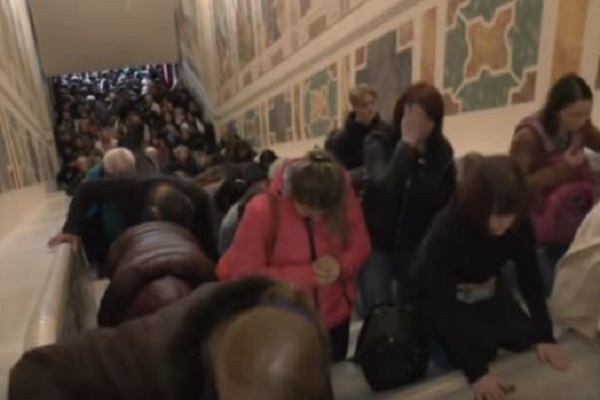
For the First Time in 300 Years Rome’s ‘Holy Stairs’ Are Open to the Public
- By Derek Welch --
- 13 Apr 2019 --

It will be open until June 9
Visitors to the Vatican can now see the Holy Stairs in all their original glory[/tweetit] as the thick wooden panels installed in 1723 will be taken away for restoration, giving way to the sight of the original marble steps. The panels had remained in place to protect the marble for the last 300 years. The devout, for about 40 days, can touch and climb the marble stones, which according to tradition, are those steps Jesus laboriously climbed when Pontius Pilate brought him before a crowd and handed him over to be crucified. The stairs will be bare from April 11 to June 9, the date corresponding to the feast of Pentecost. Pilgrims can only use their knees to climb these marble steps.
For the First Time in 300 Years Rome’s ‘Holy Stairs’ Are Open to the Public[/tweetthis]
The Holy Stairs were initially installed in Jerusalem and are those which ascended to the praetorium commanded by Pontius Pilate. As per traditional lore, St. Helena brought the stairs to Rome during the fourth century. Helena is the mother of Constantine the Great and it is believed she restored multiple historical sites in the Holy Land. According to legend, she also found the True Cross. The public saw the first glimpse of the stairs when Pope Sixtus V opened them for piety. They are to be found near Archbasilica of St. John Lateran. Pope Benedict XIII used wood to cover the Holy Stairs in 1724 to protect them.
The decision to open the stairs to the public was taken during the final phase of the restoration of the sanctuary. The complete project will take 20 years to finish. The Vatican museum is overseeing the effort. Funding is being provided by an amalgamation of foundations, private donors, and Patrons of the Arts in Vatican Museums.
Shinned my way up these stairs too. ❤️✝️#blessedhttps://t.co/4ahih6NB4A
— Maggie M (@maggiernbsn) April 11, 2019
The marble on the stairs bear the furrows left by millions of pilgrims who went over it during the preceding centuries. The friction caused by knees, hands, and feet have led to so much wear in some parts that the underlying rough stone can be seen. The empirical effect is like a water cascade, frozen in time. A few grooves split at a particular grate, with medieval cross markings, which covers a specific spot the religious believe to be the vestiges of Jesus’ blood stain. The marble itself has been weathered down by thousands of pilgrims poking fingers through this grate over thousands of years.



















